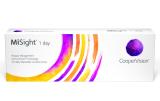Monovision contact lenses are one way that we can correct the focusing problems associated with the condition presbyopia. But what are they and how do they work? We introduce you to monovision contacts and walk through how they alleviate certain vision problems.
What’s presbyopia?
Presbyopia, a word that meant “the elderly eye” in Greek, is a symptom of aging eyes. As you age, the lens of your eye becomes increasingly rigid and inflexible: it can no longer adjust its shape as easily to allow you to focus on both near and distant objects.
Many people notice the effects of presbyopia in their early to mid-40s, as they find themselves holding reading materials at arm’s length in order to focus clearly.
What are monovision contact lenses?
Monovision contact lenses are one of several common ways that people correct for presbyopia as they age. In order to address the difficulty in changing focus between near and far, one contact lens is prescribed for near vision and the other contact lens for distance.
Other options for presbyopia
In addition to monovision contact lenses, eye doctors address presbyopia with
- Bifocal eyeglasses or bifocals: These are the most common solution, where a reading segment is incorporated into the primary lens of the eyeglass.
- Progressive glasses: Some glasses use corrective lenses (called progressive additional lenses, progressive power lenses or multifocal lenses) with a gradient of increasing power.
- Multifocal contact lenses: These are contact lenses that, like bifocal or progressive eyeglasses, have multiple focal points. Some are designed as bifocal contact lenses, where the eye shifts to view through a reading power; others are designed to allow the eye to look constantly through the center of the lens.
- A prescription for reading glasses to be worn over standard prescription contact lenses for normal (distance) viewing.
Choosing monovision contact lenses
Monovision contact lenses involve an adjustment period, which is an important consideration if you’re starting or switching contact lenses. Your brain naturally learns to adapt to this setup, where each eye is dedicated to a certain task. (Usually, your dominant eye will be designated for regular, or distance, vision.)
Another consideration is how a monovision system affects your natural binocular vision (your eyes work in tandem to address various visual tasks). Studies have shown that many patients using monovision contact lenses still retain characteristics of binocular vision and have comparable visual performance.
As with all contact lenses, talk to your eye doctor about the best way to address your particular visual problems. If you and your eye doctor choose monovision contact lenses, he or she can help make sure that the contacts suit your individual eyes, vision and context.






